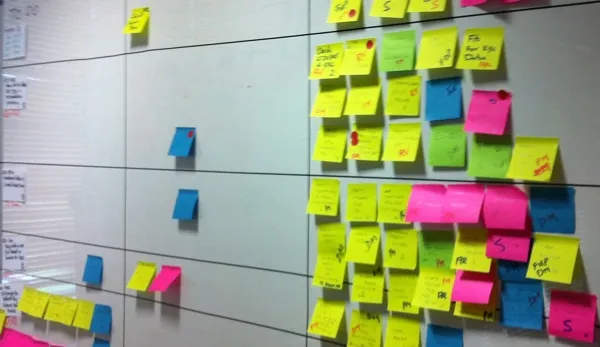by Jeff Swisher | Morton High School
Project-Based Learning (PBL) is a dynamic educational approach that promotes student engagement, critical thinking, and collaboration. As an educator, I quickly realized that I was the project manager of 22 projects, and my student’s needed agency in their own projects. This is where Scrum boards come in, providing a real-world framework that offers students opportunities to explore real-world problems, work in teams, and develop essential skills. Derived from the Scrum framework, a Scrum board is a valuable asset in facilitating and tracking project progress. With years of experience as a software developer and project manager using Agile methodologies, I have witnessed firsthand the effectiveness of Scrum boards in organizing and optimizing project workflows.
As a software developer and project manager for years, using Agile development. A Scrum board was in the front and center in my office. A Scrum board serves as a central hub for task management, fostering effective communication and empowering teams to deliver high-quality results. By offering a clear and organized way to track and manage tasks throughout a project’s lifecycle, the Scrum board enhances transparency, collaboration, and efficiency within a team. Whether used in software development, educational settings, or any other project-based environment, Scrum boards provide teams with a visual representation of work in progress, promoting accountability and enabling informed decision-making.

In this article, we explored the benefits of integrating Scrum boards into PBL, how they support effective collaboration and task management, and provided practical guidance on implementing Scrum boards in the classroom. By setting up a Scrum board, defining tasks, estimating effort, and moving tasks across the board, students can effectively track their progress, prioritize work, and identify bottlenecks or dependencies. Daily stand-up meetings and retrospective meetings further enhance communication and reflection within the team.
Benefits of Using Scrum Boards in PBL
- Visualizing project progress: Scrum boards offer a clear visual representation of project tasks, enabling students to see the status of each task and the overall progress of the project. This visibility fosters a sense of ownership and accountability among students.
- Promoting collaboration: Scrum boards encourage teamwork by providing a central platform for students to coordinate and share information. Team members can easily identify who is responsible for each task, facilitating effective communication and collaboration.
- Enhancing task management: Scrum boards help students break down complex projects into manageable tasks. By organizing tasks into columns such as “To-Do,” “In Progress,” and “Done,” students can track their progress, prioritize work, and identify bottlenecks or dependencies.
Implementing Scrum Boards in PBL
Setting up the Scrum board: Choose a visible location in the classroom to display the Scrum board. Create columns on the board to represent different stages of work, such as “To-Do,” “In Progress,” and “Done.” You can add additional columns for “Assistance Required,” “Blocked,” “Waiting on Others,” etc. Assign sticky notes or index cards for individual tasks. I color-coded sticky notes for each project group. However, I had more groups than colors, so I also numbered each color.
Usage
- Defining tasks: Begin by breaking down the project into smaller tasks or sub-tasks. Write each task on a separate sticky note or index card and place them in the “To-Do” column. Encourage students to contribute to task identification and ensure that tasks are specific, measurable, attainable, relevant, and time-bound (SMART).
- Estimating effort: Optionally, students can estimate the effort or time required for each task. This estimation helps with prioritization and resource allocation. Students can assign a numerical value to each task, such as story points, to represent the effort involved.
- Moving tasks across the board: As students work on their tasks, they move the corresponding sticky notes or index cards across the columns. Tasks in progress go into the “In Progress” column, and completed tasks are moved to the “Done” column. Regularly review the board as a team to discuss progress, challenges, and adjustments.
- Daily stand-up meetings: Implement brief daily stand-up meetings where students share updates on their tasks, identify any obstacles, and coordinate efforts. This helps to maintain transparency, address issues promptly, and ensure alignment within the team.
- Retrospective meetings: Periodically conduct retrospective meetings to reflect on the team’s performance. Discuss what worked well, what could be improved, and make adjustments to optimize the project’s execution. Encourage students to share their insights and suggestions.
Step 1: Set up the Scrum Board
- Choose a suitable location: Find a visible and easily accessible area in the classroom to display the Scrum board. It could be a wall, whiteboard, or corkboard.
- Divide the board: Create three vertical columns labeled “To-Do,” “In Progress,” and “Done.” These columns represent the stages of work.
- Add headers: Under each column, include headers with project-specific titles or the names of different tasks or deliverables.
- Use sticky notes or index cards: Use sticky notes or index cards to represent individual tasks or work items. Each task should be written clearly and concisely.
Step 2: Populate the Scrum Board
- Define project tasks: Break down the project into manageable tasks or sub-tasks. Write each task on a separate sticky note or index card.
- Prioritize tasks: Arrange the tasks in the “To-Do” column based on their priority. The most critical tasks should be at the top.
- Estimate task effort: Optionally, assign estimated effort or time required for each task. This helps in planning and resource allocation.
Step 3: Move Tasks across the Scrum Board
- Select tasks: Each team member can choose a task from the “To-Do” column and move it to the “In Progress” column.
- Update status: As team members work on their tasks, they should update the status of their work by moving the corresponding sticky notes or index cards across the columns. Tasks in progress go in the “In Progress” column.
- Track progress: Regularly review the Scrum board as a team to get an overview of the project’s progress. Discuss any challenges, dependencies, or adjustments that need to be made.
Step 4: Complete and Reflect
- Finish tasks: Once a team member completes a task, they can move the sticky note or index card to the “Done” column.
- Celebrate achievements: Celebrate and acknowledge the completion of tasks or milestones. It fosters motivation and team spirit.
- Reflect and adapt: Hold regular retrospective meetings to reflect on the team’s performance. Discuss what went well, what could be improved, and make necessary adjustments to the project plan.
Implementing a Scrum board in your project-based environment can significantly enhance productivity, collaboration, and overall project success. By utilizing this visual tool, teams gain a clear overview of project tasks, progress, and priorities, enabling them to make informed decisions and effectively manage their work. The transparency offered by a Scrum board promotes accountability and empowers team members to take ownership of their tasks. Additionally, the collaborative nature of the Scrum board fosters effective communication, coordination, and problem-solving within the team. Whether you opt for a physical or digital Scrum board, the key is to tailor it to your specific needs and ensure its accessibility to all team members. By embracing the Scrum board approach, you can streamline your project management processes, maximize efficiency, and deliver successful outcomes. So, start implementing a Scrum board today and witness the transformative power it brings to your project-based learning or work environment.




